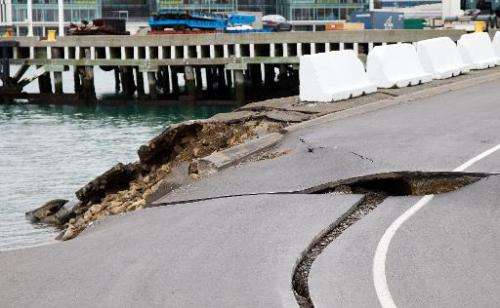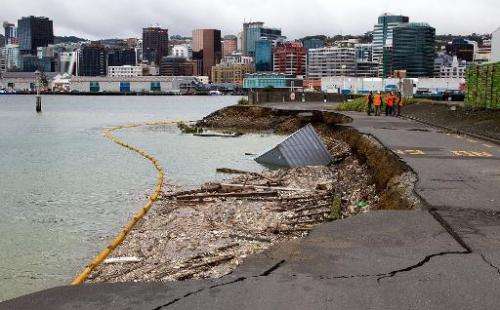Major new fault found in New Zealand capital

A new geological fault capable of generating a 7.1-magnitude earthquake has been found in Wellington, confirming the New Zealand capital's status as one of the world's most seismically active cities, scientists revealed Wednesday.
Geologists from the official NIWA research agency said the Aotea fault began on the floor of Wellington Harbour and was believed to extend through the central city and southern suburbs.
NIWA marine geologist Philip Barnes said there was evidence that the most recent earthquake caused by the fault occurred about 6,200 years ago and it was impossible to know if another temblor was overdue.
"We do believe that it has recurrence intervals of several thousand years," he told reporters. "We have no idea when it might rupture in the future."
New Zealand Prime Minister John Key said it was "fanciful" to suggest the country's capital should be moved because of the quake threat.
"It doesn't actually change anything—there are other big fault lines in Wellington," he told reporters.
"This just shows we're getting better at finding out where they are."
GeoNet earthquake geologist Russ Van Dissen said the latest discovery was just one of "dozens" of active faults crisscrossing the Wellington terrain, the biggest capable of generating an 8.5-magnitude tremor.
He said the city's existing building codes should deal with any quake from the new fault.
"There's no way of saying that a magnitude seven is inconsequential, it would be damaging," he said. "But the level of shaking for this fault, we anticipate, would be less than what this city's already designed for."
Van Dissen said there were probably more undiscovered faults beneath the city.

"How does it compare internationally? You've got the North Anatolian fault going right through Istanbul, there's a number of other cities, Tokyo, San Francisco, Los Angeles, Seattle that all have a significant active fault earthquake hazard," he said.
New Zealand, known colloquially as the Shaky Isles, lies on the boundary of the Australian and Pacific tectonic plates, forming part of the so-called "Ring of Fire", and experiences up to 15,000 tremors a year.
In 2011, a devastating 6.3-magnitude quake on a previously unknown fault in the South Island city of Christchurch killed 185 people—one of the nation's deadliest disasters of the modern era.
Wellington was the scene of the country's most powerful earthquake in 1855.
That 8.2-magnitude jolt changed the city's entire geography, pushing the shoreline out 200 metres (660 feet) as it thrust the harbour floor upwards, but only caused four deaths.
The capital has experienced three quakes measuring 6.3 or above since July last year, with little damage beyond items falling off shelves and cracked masonry.
Shaking from a 5.1 tremor on the other side of the North Island was felt in the city as recently as Monday, barely raising comment among locals.
© 2014 AFP
















